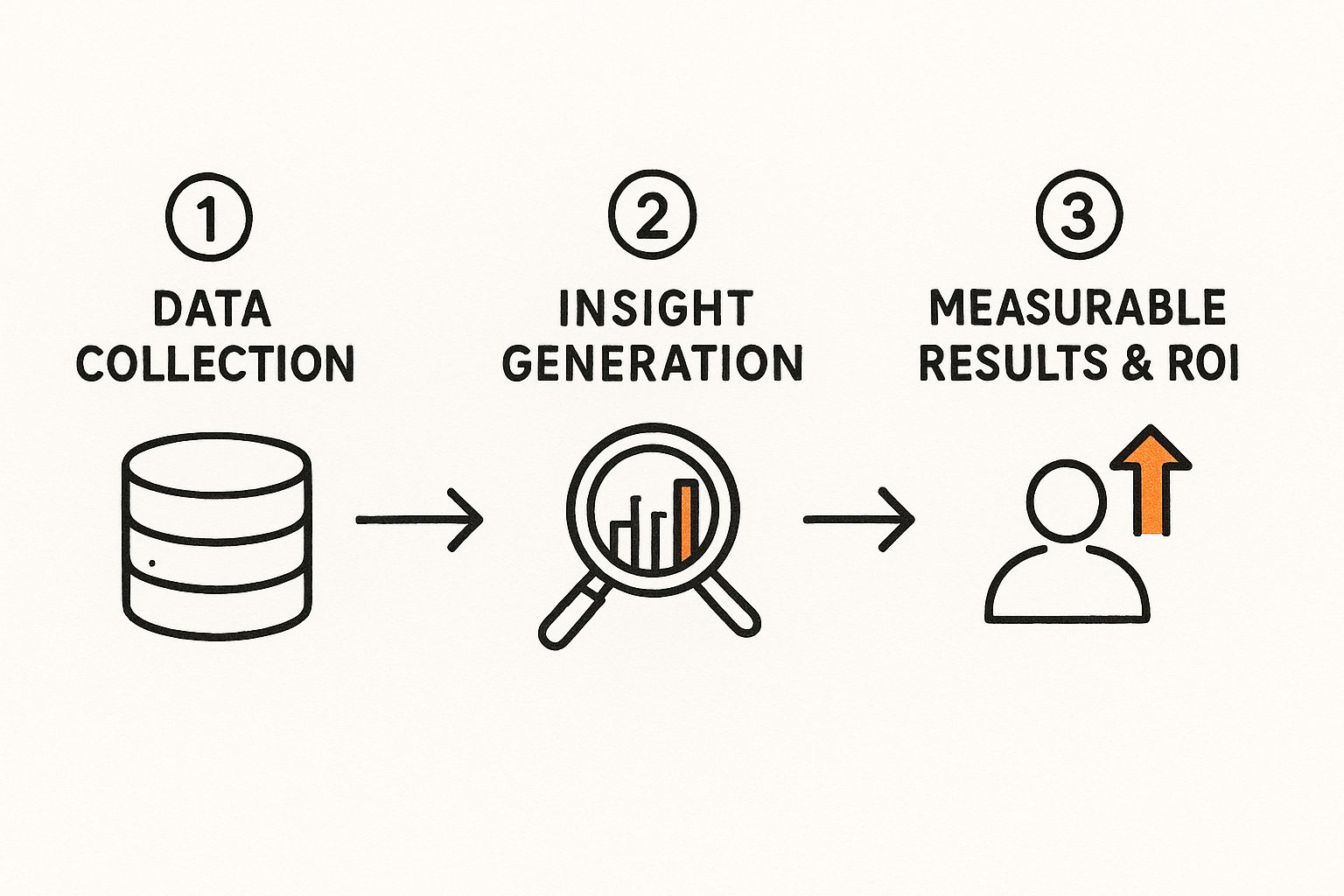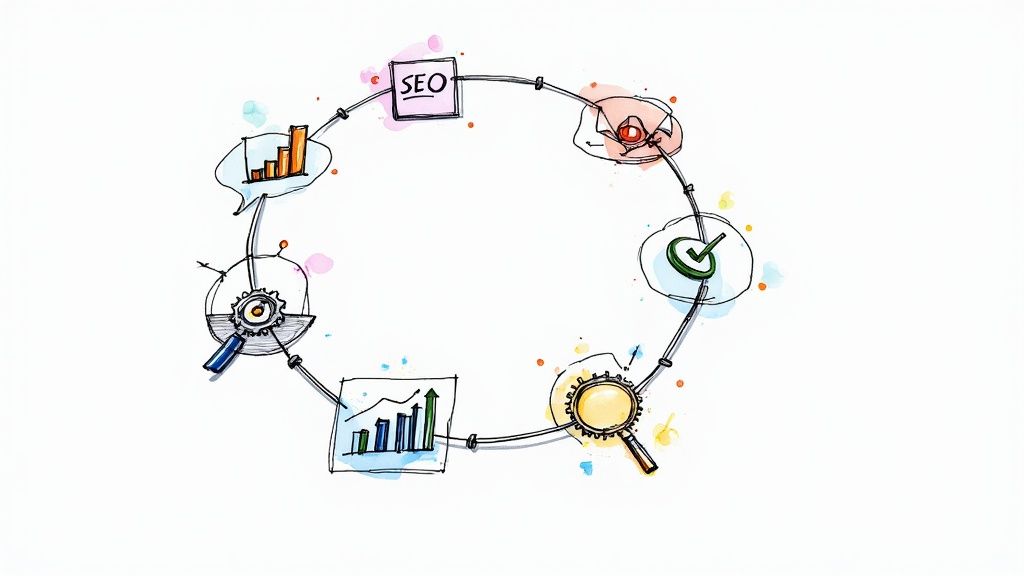
Data Driven Content Marketing A Complete Guide
Ever had that feeling you're reading your audience's mind?That's the magic of data-driven content marketing. It’s less about creative shots in the dark and more about building predictable, high-performance business assets. You're not just hoping your message lands—you know it will.
From Guesswork to Growth: The Power of Data

For a long time, content creation was purely an art form. Marketers would brainstorm topics they thought would hit the mark, write some great copy, and cross their fingers. While that creativity is still crucial, this approach often feels like sailing without a compass. You might eventually find land, but you're just as likely to get lost at sea.
Data-driven content marketing is that compass. It uses hard facts about your audience, market trends, and content performance to guide every single decision you make. Think of it like a chef who knows each customer's favorite ingredients and past orders, instead of just following a generic recipe. The result isn't just a meal; it's an experience they'll remember.
Why Data is a Modern Must-Have
This isn't just a fleeting trend. It's a necessary shift driven by a smarter audience and a tougher regulatory world. In fact, 64% of marketing executives now strongly agree that data-driven strategies are critical. A big reason for this is the rise of privacy laws like GDPR and the California Consumer Privacy Act, which have made gathering your own first-party data more important than ever. You can learn more about how these shifts are shaping marketing.
This change pushes marketers to build real relationships by collecting data directly from their audience. The result? More authentic and effective content that truly connects.
"Data is never just about the data—it’s how we use and make sense of the data. How we interpret the data is subject to the same human biases and foibles that drive everything else we do."
This quote nails it. Data isn't a silver bullet. It needs thoughtful human interpretation to turn raw numbers into real insights. The goal is to swap assumptions for evidence, turning your content from a simple expense into a measurable, valuable asset.
Data-Driven vs. Traditional Content Marketing At a Glance
So, what does this shift actually look like in practice? The table below breaks down the fundamental differences between the old way and the new, data-backed approach. It really highlights how every stage of the content process is transformed.
As you can see, the data-driven model is far more intentional. It’s a strategic cycle of listening, creating, measuring, and refining that leads to real, sustainable growth.
Fueling Your Strategy with the Right Data
A powerful content strategy doesn't run on inspiration alone; it runs on high-quality data. Think of data as the fuel for your content engine. Without it, you're just guessing. But with the right fuel, you can create experiences that are perfectly tuned to your audience, driving them exactly where they need to go.
The secret is knowing which types of "fuel" to use and where to find them. Not all data is created equal, and understanding the difference is the first step in building a system that informs every single piece of content you create.
Understanding the Three Core Data Types
Your journey into data-driven content marketing starts with knowing your sources. Each one offers unique advantages, and the most effective strategies almost always blend all three to get a complete picture.
First-Party Data: This is the information you collect directly from your audience. It's your most valuable asset because you own it, it’s incredibly accurate, and it comes with consent. Think of it as having a direct conversation with your customers.
Second-Party Data: This is essentially someone else's first-party data that you get through a direct partnership. For example, a hotel might team up with an airline to share audience insights for a joint marketing campaign. It’s a great way to get a new perspective from a trusted source.
Third-Party Data: This data is pulled together from tons of outside sources and sold by data providers. While it can be useful for broad market research, it’s far less specific and is quickly becoming less reliable due to new privacy regulations.
Your first-party data is your strategic advantage. It’s the direct feedback loop between you and your customers, telling you what they love, what they need, and where their pain points are. No other data source can offer that level of intimacy and accuracy.
Building a strong foundation with first-party data isn't just a good idea; it's critical. It respects user privacy while delivering the sharpest insights for creating content that genuinely connects and solves real problems.
Where to Find Your Content Fuel
Now that you know the types of data, where do you actually find it? This information is often closer than you think, usually hiding in plain sight within the tools you already use every day.
Here are some of the best places to start digging:
Your CRM System: Your Customer Relationship Management platform is an absolute goldmine. It's packed with direct feedback from sales calls, support tickets, and customer chats that reveal common questions, challenges, and motivations. This is also where you can use tools like lead scoring software to identify which content-generated leads have the highest potential.
Website Analytics: Tools like Google Analytics show you exactly how people find and interact with your content. You can see which pages are the most popular, how long people stick around, and the paths they take through your site. This data is a direct signal of what topics are grabbing attention right now.
Social Media Insights: Your social channels offer real-time feedback. Pay close attention to the comments, shares, and questions people leave on your posts. Social listening tools take this a step further by tracking brand mentions across the web, giving you an unfiltered look at what your audience is really talking about.
Ethically Collecting First-Party Data
As third-party cookies crumble, your ability to ethically collect first-party data becomes a massive competitive advantage. It all comes down to a simple value exchange: you provide excellent content or experiences, and in return, your audience gives you information.
Start with clear and transparent collection methods. This could be anything from a newsletter sign-up that promises exclusive content, an interactive quiz that delivers personalized results, or a survey asking for direct feedback. When you're upfront about what you're collecting and why, you build the trust needed to get the very insights that will help you serve your audience better.
The Modern Content Creation Workflow
So you’ve got a mountain of high-quality data. Now what? The real magic happens when you turn those raw numbers and insights into brilliant articles, videos, and social media posts that people actually want to consume.
The modern content workflow isn't a straight line from idea to "publish" anymore. It's a living, breathing cycle. Think of it as a powerful, scalable engine for growth where data fuels every single step. This isn't about letting algorithms take over; it’s about giving your creative team superpowers. When you blend human expertise with smart technology, you can consistently create content that truly connects with your audience and hits your business goals.
Stage 1: Data-Informed Ideation
The best content strategies start with ideas grounded in solid evidence, not just a good hunch. This is data-informed ideation. It’s about using your audience insights to find topics that solve real problems, answer pressing questions, and spark genuine interest. Your goal is to find that sweet spot where what your audience is searching for overlaps with what your brand does best.
Instead of a guessing game in a conference room, your team dives deep into the data:
- Search Data: What exact phrases are your potential customers typing into Google? What questions are they asking? Tools like SEMrush or Ahrefs give you a blueprint for relevant topics, using the precise language your audience uses.
- Customer Feedback: What are the most common questions your sales and support teams hear over and over? Digging into CRM data, support tickets, and chatbot logs uncovers recurring challenges—which are perfect starting points for helpful content.
- Social Listening: What are people in your industry actually talking about right now? By monitoring social media and forums, you can see what topics are trending and understand the opinions your audience holds.
Starting here ensures every piece of content you create has a built-in audience from the get-go.
Stage 2: AI-Assisted Creation
This is where things get really interesting. In 2025, smart content marketing is all about data and technology. In fact, over 80% of marketers worldwide now use AI tools in their digital marketing strategies. These tools aren't just for basic blog posts anymore; they help with everything from creation to running more efficient campaigns. You can dig into this and other trends in these key content marketing statistics on Typeface.ai.
But notice the key phrase: "AI-assisted." AI is an incredibly powerful partner, but it's not a replacement for human creativity and insight. Here’s what that partnership looks like in practice:
- AI Drafts the Outline: You feed your data-backed topic and keywords into an AI tool, and it generates a solid, structured outline. This can save you hours of groundwork.
- Humans Add the Soul: A human writer then takes that skeleton and breathes life into it. This is where you add unique perspectives, brand voice, compelling stories, and real empathy. AI can’t fake personal anecdotes or deep industry expertise.
- AI Refines and Polishes: Finally, use AI tools to check grammar, improve readability, and fine-tune the copy for a specific tone. This frees up your writers to focus on the big-picture strategy and creativity.
The whole point is to create a workflow where human expertise guides AI's efficiency. Let the machine handle the tedious stuff so your team can focus on what really matters: making a connection with other people.
Stage 3: Strategic Distribution
Even the most amazing content is useless if the right people never see it. Data is your roadmap for making sure your content gets maximum visibility. It tells you the best channels to use and the best times to post.
This infographic breaks down the fundamental process of turning data into real-world results.

This flow—from collecting data to generating insights and, finally, to seeing a measurable return—is the heart of a successful data-driven strategy. Analytics from your website and social media platforms will show you exactly where your audience hangs out and when they're most active. This lets you deploy your content with precision, whether that means publishing a blog post when email open rates are highest or promoting a video on LinkedIn when key decision-makers are online.
Stage 4: Continuous Optimization
The modern workflow doesn’t stop when you hit "publish." It’s a continuous loop of measuring, learning, and refining. Every single piece of content you release is a chance to gather more data and get smarter for the next round.
You'll track the key metrics that tie back to your original goals, like conversion rates, time on page, or lead generation. This data then feeds right back into the ideation stage, creating a system that improves on its own.
If a certain topic or format knocks it out of the park, you double down. If another one falls flat, you figure out why and adjust. This constant process of iterating is what turns a good content strategy into an unstoppable one.
Building Audience Trust with Data

In a world drowning in generic claims and fluffy content, trust is the most valuable thing you can build. While we all love seeing our performance metrics go up, the real magic of data-driven content is its power to forge genuine, lasting relationships with your audience.
It’s the difference between being just another company shouting online and becoming the go-to, credible voice people actively seek out.
This all starts with being transparent. When you back up what you say with hard facts and original research, you’re not just telling your audience something—you’re showing them why it’s true. This simple act of providing evidence builds a foundation of credibility that vague promises can never hope to match.
Turning Feedback into Proactive Content
One of the most effective ways to build trust is to prove you're actually listening. Your customer support tickets, sales call notes, and social media comments are a goldmine—a direct line into your audience's biggest headaches and burning questions.
Don't just use this data to tweak your product; use it to fuel your content.
When you spot recurring issues or common points of confusion, you can create content that solves these problems before they even pop up for other users. Imagine a customer wrestling with a specific feature, only to stumble upon a detailed video tutorial you created based on feedback from others in their shoes. That shows you're paying attention and you genuinely care.
By transforming customer feedback into helpful content, you flip the script from reactive problem-solving to proactive guidance. It shows your audience you get their journey and are invested in their success, which builds incredible loyalty.
This isn't just a nice-to-have. A recent Statista survey found that nearly 50% of B2B marketers now say building trust is a primary goal for their content. With so much information out there, credible, data-backed content is your best bet for cutting through the noise and proving you’re the real deal. You can see how marketers are prioritizing trust in 2025 on byyd.me for the full rundown.
Pinpointing High-Trust Channels and Formats
While what you say matters immensely, where and how you say it are just as crucial for building a trustworthy brand. Data can point you to the channels and formats where authentic connections are born. After all, different platforms foster different kinds of relationships.
Here are a few high-trust formats to lean into with your data-driven content:
- Detailed Case Studies: These are so much more than a simple testimonial. They present a data-backed story of success, showing—not just telling—how you solve real problems for people just like them.
- Expert Interviews: Bringing in recognized industry experts lends their credibility to your brand. It positions you as a curator of valuable conversations, not just a self-promoter.
- Original Research Reports: Publishing your own data makes you a primary source of information. It’s a ton of work, but the payoff in authority, backlinks, and media mentions can be massive.
- Interactive Video Content: Formats like live Q&As or interactive demos open up a two-way street. By letting viewers ask questions or choose their own path through a video, you create a much more personal connection. For more on this, check out our guide on creating a personal experience in video marketing.
By using data to pick the right channels and create transparent, evidence-based content, you build more than just a following. You build a loyal community that sees you as a reliable partner.
Measuring Content Performance and ROI
Hitting “publish” on a brilliant piece of content feels like a huge win, but that’s not where the journey ends. To keep the investment coming and to get better at what you do, you have to prove your content actually works. This is where a data-driven approach really shows its muscle, taking you beyond surface-level stats to demonstrate real business impact.
It’s time to move past the “vanity metrics” like likes, shares, and page views. Sure, they can signal a spark of interest and give you a nice little ego boost, but they don't tell the whole story. More importantly, they don’t give you clear directions on what to do next to drive actual growth. The real goal is to draw a straight line from your content to your business objectives.
Tying Content to Business Goals
To measure what really matters, you first have to define what success looks like for your company. A smart, data-driven strategy connects every blog post, video, or webinar to a specific, measurable outcome. Are you trying to get more qualified leads? Boost sales for a certain product? Or maybe cut down on customer support tickets?
Once you’ve got that core objective locked in, you can pick out the Key Performance Indicators (KPIs) that show you’re moving in the right direction. This simple shift in focus takes you from chasing simple engagement to tracking meaningful action.
Here are a few powerful KPIs to get you started:
- Conversion Rate: What percentage of people who engage with your content take the next step you want them to? This could be anything from signing up for a newsletter to downloading a whitepaper or requesting a demo.
- Lead Quality: Are the leads coming from your content actually turning into paying customers? Tracking this helps you figure out which content is attracting the right kind of prospects.
- Content-Influenced Revenue: This is the big one. How much revenue can you trace back to a customer interacting with your content? This is the ultimate proof of ROI.
- Audience Retention: For video, metrics like watch time and drop-off rates are gold. They tell you exactly how engaging your content is and pinpoint the moments where you’re losing your audience’s attention.
True ROI isn't just about traffic; it's about transformation. The most valuable data shows how your content influenced a prospect's journey from a curious visitor to a loyal customer. This is the evidence that justifies budgets and fuels future strategies.
Setting Up Attribution Models
One of the trickiest parts of measuring ROI is figuring out how all your different content pieces work together to land a conversion. A customer might read a blog post, watch a video, and then join a webinar before they finally decide to buy. So, who gets the credit? This is where attribution modeling comes into play.
An attribution model is just a framework for giving credit to the various touchpoints along a customer’s journey. Instead of handing all the glory to the very last thing they saw, it helps you see the entire picture.
There are a few common models to think about:
- First-Touch Attribution: This gives 100% of the credit to the very first piece of content a customer engaged with. It’s fantastic for understanding what content is best at bringing new people into your world.
- Last-Touch Attribution: The exact opposite. This model gives all the credit to the final touchpoint before a conversion. It helps you see which content is most effective at sealing the deal.
- Multi-Touch Attribution: These models spread the credit across multiple touchpoints. A linear model gives equal credit to every interaction, while a time-decay model gives more credit to the interactions that happened closer to the conversion.
Picking the right model really depends on your sales cycle and business goals. The most important thing is to choose one and stick with it so you can build a clear, consistent view of what’s actually working.
Building Your ROI Dashboard
With your KPIs and attribution model set, the final piece of the puzzle is pulling all that data together in a way that’s actually easy to digest. A well-designed ROI dashboard gives you a clean, at-a-glance view of your content's performance.
Tools like Google Analytics, SEMrush, and HubSpot are your best friends here. You can set up dashboards to track your chosen KPIs in real-time, letting you spot trends, identify your star performers, and make quick, data-backed decisions to tweak your strategy. For deep video insights, it's absolutely vital to track things like viewer engagement and drop-off points; you can learn more about the crucial video engagement metrics that guide content creation and what they reveal about your audience.
By measuring performance this way, you stop hoping for results and start engineering them. You gain the confidence to defend your budget, prove your team's value, and build a content engine that delivers predictable, sustainable growth for the business.
Data Driven Content Marketing in Action
 Theory is a great starting point, but the real magic happens when you see data-driven content marketing actually working in the wild. These strategies aren't just buzzwords on a slide deck; they deliver real, measurable results for businesses that are willing to listen to what their data is telling them.
Theory is a great starting point, but the real magic happens when you see data-driven content marketing actually working in the wild. These strategies aren't just buzzwords on a slide deck; they deliver real, measurable results for businesses that are willing to listen to what their data is telling them.
Let's move past the "how-to" and look at the direct impact. By breaking down a couple of real-world scenarios, you can see just how powerful this approach is and get a practical blueprint for your own work.
The B2B SaaS Resource Hub
A growing B2B SaaS company had a problem we've all seen before: generating a steady stream of high-quality leads. Their old strategy of writing blog posts about company updates just wasn't cutting it. It wasn't attracting anyone new. So, they decided to switch things up and put data first.
They started by digging into two crucial data sources:
- Search Data: Using their SEO tools, they hunted down high-intent keywords and specific questions their ideal customers were typing into Google. They focused on the core problems their software solved.
- Customer Interviews: The team went back through notes from sales calls and support tickets, pulling out the exact language and recurring pain points their customers mentioned over and over.
This data painted a crystal-clear picture: people desperately needed a central place for answers. So, they built a comprehensive resource hub filled with in-depth guides, checklists, and video tutorials that directly tackled the issues they'd uncovered.
The result? The resource hub became their #1 lead generation engine. It drew in qualified traffic and led to a huge spike in demo requests.
By letting audience needs—not company news—drive their content plan, they turned a self-promotional blog into a problem-solving machine that fueled actual business growth.
The E-commerce Personalized Experience
An e-commerce brand was battling a high cart abandonment rate, a metric that was killing their bottom line. Instead of just sending out the same old "You left something behind!" emails, they decided to figure out why people were leaving in the first place.
They dove deep into their purchase data and on-site behavior, and some interesting patterns emerged. They found that customers who bought a certain product were extremely likely to want a specific accessory—but they usually didn't even know it existed.
Armed with this insight, they completely revamped their content strategy. They produced short, interactive videos that showed how the main products and their companion accessories worked together beautifully. These weren't boring product demos; they were engaging, helpful experiences. For more on this, check out how you can use interactive video to rocket-charge your content marketing success.
They strategically placed these personalized videos on product pages and inside their abandoned cart email sequences. This data-backed personalization led to a 22% reduction in cart abandonment and a nice lift in their average order value.
Both of these examples show how getting specific with data can inspire content that solves a direct business problem. It’s clear proof of just how valuable a data-driven approach really is.
Frequently Asked Questions
Jumping into data-driven content marketing can feel like a big step, and it's totally normal to have a lot of questions. Let's tackle some of the most common ones I hear, so you can get your strategy rolling with confidence.
How Do I Start Data-Driven Content Marketing on a Small Budget?
This is a big one. A lot of people think you need a massive budget and a suite of expensive enterprise tools, but that’s just not true. The trick is to start with the powerful, free data sources you already own.
Your first-party data is where the gold is—it's incredibly accurate, and it costs you nothing.
Here are a few places to start without spending a dime:
- Google Analytics: Seriously, dive in. Look at your most popular pages, see where traffic is coming from, and check out how people behave on your site. This tells you what topics are already hitting the mark with your audience.
- Customer Feedback: This is a direct line to your audience's brain. Systematically look through your blog comments, social media questions, and customer service emails. You’ll find their exact pain points and interests, completely free.
- Google Search Console: This tool is an absolute goldmine. It shows you the exact search terms people use to land on your site. It doesn't get more data-informed than creating content that directly answers those queries.
By starting here, you can build a rock-solid foundation for your data-driven content marketing without opening your wallet.
What Are the Best Tools for Beginners?
When you're new to this, the best tools are the ones that are easy to use and give you clear insights quickly. You want to avoid getting bogged down in overly complex platforms before you're ready.
Think about adding these to your starter toolkit:
- An SEO Tool: Platforms like Ahrefs' free Webmaster Tools or the free tiers of Ubersuggest are fantastic. They’ll help you with keyword research, checking out the competition, and tracking your rankings—all fundamental tasks for a data-driven approach.
- A Social Listening Tool: You can get valuable insights from free tools like TweetDeck or even just the native analytics inside Facebook and Instagram. They’re great for gauging audience sentiment and spotting trending topics.
- An Analytics Platform: Google Analytics is non-negotiable. It gives you a deep, comprehensive look at how users interact with your content, providing the hard data you need to make smart optimizations.
The best tool for a beginner is one you will actually use. Start small, get really good at one platform, and only add to your toolkit when you have a specific problem that your current setup can't solve.
How Can I Measure Success Without a Data Analyst?
You absolutely can measure your success without a data analyst on the payroll. The secret is to stop trying to track everything. Instead, focus on a handful of core metrics that tie directly back to your actual business goals. This helps you avoid "analysis paralysis" and keeps you focused on what matters.
A great starting point is to build a simple dashboard using a free tool like Google Looker Studio (which used to be called Data Studio). Connect it to your Google Analytics and track just a few key performance indicators (KPIs).
Focus on answering simple, direct questions:
- Which content drives the most newsletter sign-ups? (Track goal completions in GA)
- Which blog posts keep people reading the longest? (Look at average time on page)
- What topics bring in the most new visitors from Google? (Check organic landing page traffic)
By concentrating on clear, business-focused metrics like these, you can easily measure your content's impact and make informed decisions to improve your strategy. No data science degree required.
Ready to turn your videos into data-gathering powerhouses? Mindstamp makes it easy to create interactive video experiences that capture viewer insights, boost engagement, and drive real business results. Discover how Mindstamp can elevate your content strategy today!
Get Started Now
Mindstamp is easy to use, incredibly capable, and supported by an amazing team. Join us!



Try Mindstamp Free










